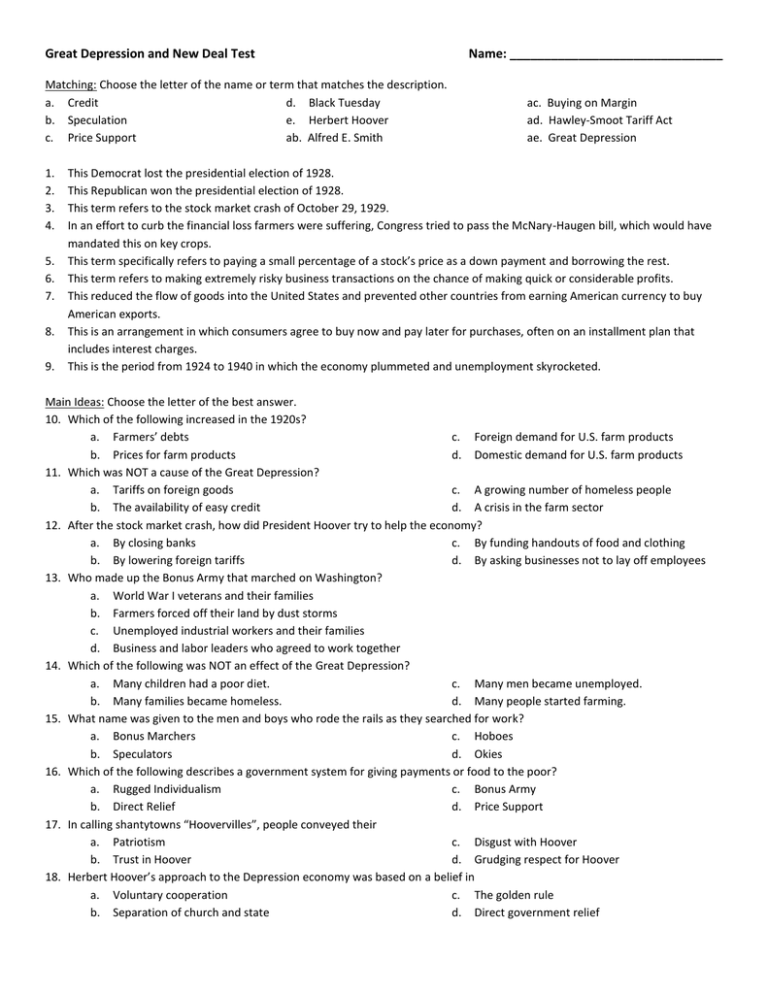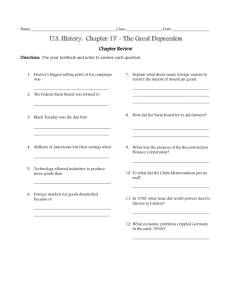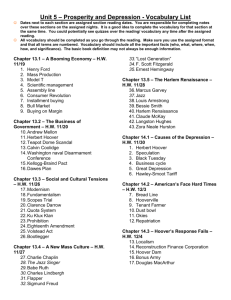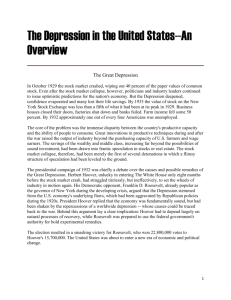Great Depression/New Deal
advertisement

Great Depression and New Deal Test Matching: Choose the letter of the name or term that matches the description. a. Credit d. Black Tuesday b. Speculation e. Herbert Hoover c. Price Support ab. Alfred E. Smith 1. 2. 3. 4. 5. 6. 7. 8. 9. Name: _______________________________ ac. Buying on Margin ad. Hawley-Smoot Tariff Act ae. Great Depression This Democrat lost the presidential election of 1928. This Republican won the presidential election of 1928. This term refers to the stock market crash of October 29, 1929. In an effort to curb the financial loss farmers were suffering, Congress tried to pass the McNary-Haugen bill, which would have mandated this on key crops. This term specifically refers to paying a small percentage of a stock’s price as a down payment and borrowing the rest. This term refers to making extremely risky business transactions on the chance of making quick or considerable profits. This reduced the flow of goods into the United States and prevented other countries from earning American currency to buy American exports. This is an arrangement in which consumers agree to buy now and pay later for purchases, often on an installment plan that includes interest charges. This is the period from 1924 to 1940 in which the economy plummeted and unemployment skyrocketed. Main Ideas: Choose the letter of the best answer. 10. Which of the following increased in the 1920s? a. Farmers’ debts c. Foreign demand for U.S. farm products b. Prices for farm products d. Domestic demand for U.S. farm products 11. Which was NOT a cause of the Great Depression? a. Tariffs on foreign goods c. A growing number of homeless people b. The availability of easy credit d. A crisis in the farm sector 12. After the stock market crash, how did President Hoover try to help the economy? a. By closing banks c. By funding handouts of food and clothing b. By lowering foreign tariffs d. By asking businesses not to lay off employees 13. Who made up the Bonus Army that marched on Washington? a. World War I veterans and their families b. Farmers forced off their land by dust storms c. Unemployed industrial workers and their families d. Business and labor leaders who agreed to work together 14. Which of the following was NOT an effect of the Great Depression? a. Many children had a poor diet. c. Many men became unemployed. b. Many families became homeless. d. Many people started farming. 15. What name was given to the men and boys who rode the rails as they searched for work? a. Bonus Marchers c. Hoboes b. Speculators d. Okies 16. Which of the following describes a government system for giving payments or food to the poor? a. Rugged Individualism c. Bonus Army b. Direct Relief d. Price Support 17. In calling shantytowns “Hoovervilles”, people conveyed their a. Patriotism c. Disgust with Hoover b. Trust in Hoover d. Grudging respect for Hoover 18. Herbert Hoover’s approach to the Depression economy was based on a belief in a. Voluntary cooperation c. The golden rule b. Separation of church and state d. Direct government relief 19. An example of the psychological stress caused by the Great Depression was the rise in the number of a. Children who were malnourished. c. Women who worked outside the home. b. People who committed suicide. d. Men who stood in bread lines. 20. One long-range effect of the Great Depression was that many people a. Grew to like President Hoover. c. Developed habits of saving and thriftiness. b. Became risk takers in the stock market. d. Came to believe in small government. 21. Within a few years, the Hawley-Smoot Tariff Act led to a. A dramatic drop in world trade. b. Hoover’s reelection as president. c. More demand for American manufactured goods. d. An unequal distribution of income in the United States. 22. Causes of the farming crisis of the 1920s included the fact that a. Demand for crops fell after World War I. b. Most people did not own electric refrigerators. c. The Dust Bowl took much land out of production. d. Federal price-supports of corn and wheat were no effective. True/False: Decide if the statement is true (A) or false (B). 23. International trade flourished in the 1930s, which was the only thing that kept our country alive economically. 24. The distribution of wealth in the United States is one of the prime causes of the Great Depression – only a few were wealthy, while the majority of the country was at or below average. 25. The stock market crash was main cause of the Great Depression. 26. The overproduction of crops, was the reason the farmers were hit the hardest during the Great Depression. 27. President Hoover’s reaction to the continued protesting by the Bonus Army earned him respect from the American people. Matching: Choose the letter of the name or term that best matches the descriptions. a. Federal Securities Act (FSA) e. Agricultural Adjustment Act (AAA) b. Glass-Steagall Banking Act ab. Emergency Banking Relief Act c. Tennessee Valley Authority (TVA) ac. National Industrial Recovery Act (NIRA) d. Civilian Conservation Corps (CCC) ad. Federal Emergency Relief Administration 28. This established the Federal Deposit Insurance Corporation (FDIC), with the greater goal of restoring public confidence in the banking system. 29. This provided direct relief in the form of food and clothing to the neediest people hit by the Depression – the unemployed, the aged, and the ill. 30. This helped to create prosperity in poverty-stricken region by providing funds to build and repair dams, flood-control projects, and power plants. 31. This paid farmers to lower production and, in some cases, to destroy crops, with the greater goal of raising crop prices and farm income. 32. This put almost 3 million young men to work building roads, developing parks, and helping in soil-erosion and flood-control projects. 33. This required corporations to provide complete information on all stock offerings, with the greater goal of restoring public confidence in the stock market. 34. This authorized the Treasury Department to inspect banks and to close those that were unsound, with the greater goal of restoring public confidence in the banking system. 35. This created an administration that set fair prices on many products and established labor standards, with the greater goal of ensuring fair business practices and promoting industrial growth. Matching: Choose the letter of the name or term that best matches the descriptions. A term may be used more than once. a. Parity e. Securities and Exchange Commission b. Federal Deficit ab. Federal Deposit Insurance Corporation c. Social Security Act ac. National Labor Relations Board d. Tennessee Valley Authority 36. 37. 38. 39. 40. 41. 42. 43. 44. 45. This provides for an old-age insurance program. This federally regulated crop price was intended to stabilize farmers’ incomes. This provides for an unemployment compensation program. This provides programs that aid needy families with children and the needy disabled. Under the second Agricultural Act, loans made to farmers were based on this value of their surplus crops. Created under the Wagner Act, this continues to act as a mediator in disputes between unions and employers. Created in 1934, this continues to monitor the stock market and enforce laws regarding the sale of stocks and bonds. Pollution was an unfortunate result of this program to promote flood control and build hydroelectric power plants. This increased during the Roosevelt administration as the federal government expected reforms to stabilize the economy. Created through the Glass-Steagall Banking Act, this shored up the banking system by protecting people’s savings against loss in the event of a bank failure. Main Ideas: Choose the letter of the best answer. 46. What was the first major action Roosevelt took as president? a. He called the first meeting of the “Brain Trust”. b. He proposed a reorganization of the Supreme Court. c. He closed all the nation’s banks and ordered inspections. d. He established the Civil Works Administration to provide job relief. 47. Which of the following was a goal of the New Deal? a. Regulate the stock market c. Decrease prices of the farm goods b. Deregulate the nation’s banking system d. Increase crop production 48. Which of the following was most directly responsible for creating new jobs and putting people to work? a. Social Security Act c. National Labor Relations Act b. Fair Labor Standards Act d. Works Progress Administration (WPA) 49. Which of the following was the main objective of the Agricultural Adjustment Act (AAA)? a. To increase farm production c. To provide pensions for retired farmers b. To raise prices of farm products d. To encourage more people to enter farming 50. Which the following pieces of New Deal legislation was ruled unconstitutional by the Supreme Court? a. Wagner Act c. Emergency Banking Relief Act b. Social Security Act d. National Industrial Recovery Act (NIRA) 51. What role did Eleanor Roosevelt play in the Roosevelt administration? a. She served as a cabinet member. b. She focused on being an excellent hostess. c. She was an important advisor on foreign policy. d. She was an important advisor on domestic policy. 52. Which of the following reached a new high during Roosevelt’s first term as president? a. Tariff rates c. The national debt b. Employment rates d. Per capita income 53. Which of the following of Roosevelt’s ideas failed to become a law? a. Federally supported loans for housing. b. The reorganization of the Supreme Court. c. The establishment of regional planning authorities. d. The creation of a federally supported pension program. 54. By decreasing farm surpluses, New Deal policies helped to a. Lower the cost of food c. Raise the price of farm goods b. Increase the food supply d. Combat the effects of the Dust Bowl 55. ___ claimed that the New Deal policies were inadequate and proposed a social program called Share-Our-Wealth. a. Huey Long c. John L. Lewis b. Francis Townsend d. Charles Coughlin 56. The Supreme Court ruled that the ___ was unconstitutional on the grounds that its provisions were local matters and should be regulated by the states. a. Federal Securities Act (FSA) c. Wagner Act b. Fair Labor Standards Act d. Agricultural Adjustment Act (AAA) 57. Of the following New Deal policies, ____ had the biggest long-term impact on the American economy. a. Social Security Act c. Tennessee Valley Authority (TVA) b. Civilian Conservation Corps (CCC) d. Federal Emergency Relief Administration 58. The ___ reflected President Roosevelt’s concerns for the natural environment. a. Civil Works Administration (CWA) c. Civilian Conservation Corps (CCC) b. National Youth Administration (NYA) d. Works Progress Administration (WPA) Matching: Choose the letter of the legislation or agency that best matches each description. a. Wagner Act ac. Works Progress Administration (WPA) b. Social Security Act ad. Securities and Exchange Commission (SEC) c. Federal Deposit Insurance Corporation (FDIC) ae. Federal Securities Act (FSA) d. Fair Labor Standards Act 59. This required corporations to provide complete, truthful information on all stock offerings. 60. This was created to reform, and to restore confidence in, the stock market by providing means to monitor the market and to enforce laws regarding the sales of stocks and bonds. 61. This set a national minimum hourly wage and prohibited factory labor for children under sixteen years of age. 62. This protected the right of workers to join unions and established the National Labor Relations Board (NLRB) to settle disputes between employers and employees. 63. This provided a pension for retired workers and their spouses and aided people with disabilities, poor mothers with dependent children, and the needy elderly. 64. Created through the Glass-Steagall Banking Act of 1933, this originally protected up to $5,000 of an individual’s bank account. 65. This addressed the problems of unemployment and poverty by creating jobs that ranged from the construction of airports and libraries to the sewing of clothing for the needy. Short Answer: Answer the following questions in the space provided. 66. Use the chart provided to help fill in the responses and to answer the question that follows (10 points). Demand Increases = Price _______________ and Quantity _________________ Demand Decreases = Price _______________ and Quantity _________________ Supply Increases = Price _________________ and Quantity _________________ Supply Decreases = Price _________________ and Quantity _________________ How did farmers benefit from price increases, and in turn, how did the economy as a whole benefit? What was a negative effect of increased prices on crops during the Great Depression? 67. In a full paragraph, DESCRIBE how the idea of homelessness and hoboes has changed over time – comparing the Great Depression period with today. Provide TWO specific examples from the video, Riding the Rails and our discussion (10 points). 68. Briefly, compare how various presidents deal with economic crisis/issues (Hoover, FDR, and Barack Obama). Include how people respond to those decisions and why (5 points).



